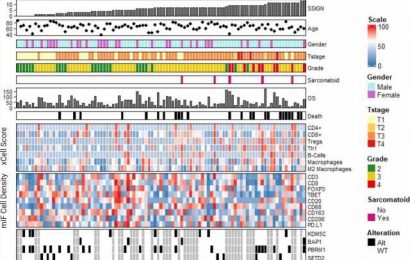The most comprehensive study to date of the blood cancer, Hodgkin lymphoma, has provided fascinating insights into what tumour cells must do to survive. Researchers from the Wellcome Sanger Institute found that cancer cells use signals to attract certain types of immune cell and instruct them not to attack.
The study, published in Blood, also found that high concentrations of these cell clusters in existing sample data predicted the failure of chemotherapy. This knowledge could be used to accelerate towards precision medicine and identify patients who might benefit from newer immune-based therapies, which are more effective in cases where traditional treatments have failed.
Hodgkin lymphoma is a cancer of the lymphatic system, an important part of the human immune system that plays a role in fighting infections and destroying abnormal cells. Hodgkin lymphoma is typified by the presence of Hodgkin / Reed-Sternberg cells, a type of white blood cell called a B lymphocyte that has become cancerous. B lymphocytes normally make antibodies to help fight infections.
Hodgkin lymphoma is a cancer with around 2,100 diagnoses in the UK each year. Though most patients respond well to chemotherapy, radiotherapy or a combination of both, for some these treatments fail. The good news is that these patients often respond well to new treatments like ‘immune checkpoint inhibitors’, especially PD-1 blockers.
In this new study, researchers combined multiple approaches to investigate the immune microenvironment around Hodgkin lymphoma tumours in unprecedented detail.
Single-cell sequencing and spatial transcriptomic data from Hodgkin lymphoma and healthy lymph node tissue were generated at the Wellcome Sanger Institute, to identify the genes expressed by each cell and their position in relation to their neighbours. This was combined with microscope imaging data from Hodgkin lymphoma biopsies from Newcastle University.
Analysis of single-cell data revealed that cancer cells were surrounded by clusters of macrophages, monocytes and cDC2 dendritic cells, which are all types of immune cell. Imaging data showed that these cells expressed molecules that suppressed their anti-tumour capabilities.
This study is a great example of how much information we can get out of one tissue sample. By combining single-cell, spatial transcriptome and histological data, we were able to learn how precisely Hodgkin lymphoma manages to evade immune response. You could think of this approach as a sort of roadmap for molecular pathology, which could be applied to other diseases as well.”
Dr Ben Stewart, First Author of the Study, Wellcome Sanger Institute.
Immunology eBook

Researchers also noted two distinct ‘microenvironments’ around cancer cells that gave indications as to how successful traditional treatments would be. High concentrations of immune cell clusters around cancer cells were predictive of treatment failure, whereas a microenvironment showing high concentrations of stromal cells was associated with treatment success. Because stromal cells indicate that tissue has been previously repaired, it may be that the immune system had already been partially successful in fighting the disease – with treatment providing a helping hand to eradicate the cancer entirely.
Understanding how Hodgkin lymphoma tumours bypass the body’s immune response opens up new possibilities to treat this disease. If we could identify which patients have higher concentrations of these immune cell clusters around the tumour, for example, we could tailor their treatments, limiting the effects of chemotherapy for patients in whom it is less likely to work and proceeding directly to immune-based therapies that stand a better chance.”
Dr Chris Carey, Senior Author of the Study, Newcastle University.
The cellular messaging used by the cancer cells to manipulate immune cells is also a potential drug target. Disrupting this signalling would in theory allow the immune system to respond as it should and attack the cancer cells.
Single-cell and spatial transcriptomic approaches are bringing a whole new level of detail for the study of human health and disease. When they are combined with other types of data, you can be incredibly specific about what is happening in the human body. This precision is key and I’m sure in time the data that we have generated in this study will have a positive impact on the treatment of Hodgkin lymphoma.”
Dr Sam Behjati, Senior Author of the Study, Wellcome Sanger Institute and Cambridge University Hospitals NHS Foundation Trust.
The Wellcome Sanger Institute
Stewart, B.J., et al. (2023) Spatial and molecular profiling of the mononuclear phagocyte network in Classic Hodgkin lymphoma. Blood. doi.org/10.1182/blood.2022015575.
Posted in: Child Health News | Cell Biology | Medical Condition News
Tags: Antibodies, B Lymphocyte, Blood, Blood Cancer, Cancer, Cell, Chemotherapy, Genes, Hodgkin Lymphoma, Imaging, Immune Response, Immune System, Lymph Node, Lymphatic System, Lymphocyte, Lymphoma, Medicine, Microscope, Pathology, Precision Medicine, Radiotherapy, White Blood Cell
Source: Read Full Article


